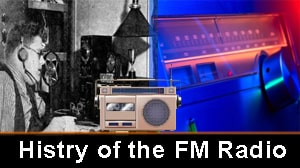Histry of the FM Radio
The history of FM (Frequency Modulation) radio is a tale of technological innovation, perseverance, and the relentless pursuit of audio excellence. From its early developments in the 1930s to its widespread adoption as a broadcasting standard, FM radio has played a pivotal role in shaping the way we experience and enjoy audio content. This article delves into the fascinating journey of FM radio, tracing its origins, key milestones, and the impact it has had on the world of broadcasting.

Table of Content
- Histry of the FM Radio
- The Genesis of FM Radio
- Highlites FM Radio Histry
- Armstrong's Breakthrough
- Challenges and Opposition
- World War II and FM Radio
- Post-War Expansion
- Stereo Broadcasting and Beyond
- Digital Revolution and Contemporary FM Radio
- Your questions and their answers related to FM Radio and history
The Genesis of FM Radio
In the early 1930s, Edwin Howard Armstrong, a brilliant American engineer, embarked on a mission to overcome the limitations of AM (Amplitude Modulation) radio. AM radio, the prevalent technology at the time, suffered from issues such as signal interference and poor audio quality. Armstrong's innovative solution was FM radio, a technology that utilized frequency modulation to transmit audio signals.
Highlites FM Radio Histry
| Period | Key Developments |
|---|---|
| Early 1930s | - Edwin Howard Armstrong begins research on FM radio |
| - Armstrong pioneers frequency modulation (FM) technology | |
| June 13, 1935 | - Armstrong successfully demonstrates FM broadcasting for the first time |
| - FM offers superior sound quality and reduced interference compared to AM radio | |
| World War II | - FM radio development interrupted by the war |
| - U.S. military recognizes FM's potential for secure communication | |
| Post-War Expansion | - FM radio experiences resurgence with technological advancements |
| - Establishment of FM stations across the U.S. and Europe | |
| 1960s | - Introduction of stereo broadcasting on FM radio |
Armstrong's Breakthrough
After years of research and experimentation, Armstrong achieved a major breakthrough on June 13, 1935, when he successfully demonstrated FM broadcasting. This marked a turning point in the history of radio, as FM offered superior sound quality, reduced static and interference, and the ability to transmit over longer distances without signal degradation.
Challenges and Opposition
Despite its technological advantages, FM radio faced initial challenges in gaining widespread acceptance. The existing AM radio industry, backed by influential broadcasters and manufacturers, resisted the adoption of FM technology. Armstrong found himself in a protracted legal battle with RCA and other companies that were heavily invested in AM radio.
World War II and FM Radio
The development and widespread use of FM radio were temporarily interrupted by World War II. During the war, the U.S. military recognized the potential of FM for secure and high-quality communication and invested in its further development. This period of military application helped refine FM technology and contributed to its eventual post-war resurgence.
Post-War Expansion
Following World War II, FM radio experienced a resurgence as technology advancements and increased manufacturing capabilities made FM receivers more affordable. The 1940s and 1950s saw the establishment of FM stations across the United States and Europe, with broadcasters recognizing the superior audio quality and enhanced listener experience offered by FM.
Stereo Broadcasting and Beyond
In the 1960s, FM radio entered a new era with the introduction of stereo broadcasting. This development further elevated the audio experience for listeners, creating a more immersive and dynamic soundstage. The stereo capabilities of FM radio became a key driver in its popularity, especially for music enthusiasts.
Digital Revolution and Contemporary FM Radio
In the late 20th century and into the 21st century, FM radio continued to evolve alongside the digital revolution. While digital platforms and streaming services gained prominence, FM radio retained its widespread appeal, offering a free and accessible means of broadcasting. The integration of FM capabilities into digital devices, such as smartphones and internet radios, ensured its continued relevance in the modern era.
Listen Live FM Radio
- America All Radio Station
- India All FM Radio Station
- Bollywood Song FM Radio Station
- Hollywood Song Radio Station
Your questions and their answers related to FM Radio and history
Q1: Who is credited with the invention of FM radio?
Ans: Edwin Howard Armstrong, an American electrical engineer and inventor, is credited with the invention of FM (Frequency Modulation) radio. He successfully demonstrated FM broadcasting on June 13, 1935.
Q2: How did FM radio differ from AM radio in terms of technology?
Ans: FM radio used frequency modulation, a technique that varied the carrier frequency according to the audio signal. This resulted in superior sound quality, reduced static, and minimized interference compared to AM (Amplitude Modulation) radio, which modulated the amplitude of the carrier signal.
Q3: What were the initial challenges faced by FM radio?
Ans: FM radio faced resistance from the existing AM radio industry, leading to legal battles. Additionally, the interruption caused by World War II temporarily halted its widespread adoption.
Q4: When did stereo broadcasting become a part of FM radio?
Ans: Stereo broadcasting was introduced in the 1960s, marking a new era for FM radio. This development enhanced the listener experience by providing a more immersive and dynamic soundstage.
Q5: How did FM radio evolve in the digital age?
Ans: In the late 20th century and into the 21st century, FM radio adapted alongside the digital revolution. It remained relevant with the integration of FM capabilities into digital devices like smartphones and internet radios.
Q6: Is FM radio still popular today, given the rise of digital platforms?
Ans: Yes, FM radio remains popular today. Despite the emergence of digital platforms and streaming services, FM radio continues to be a widely accessible and free broadcasting medium, offering diverse content to listeners globally.
Q7: What role did Edwin Howard Armstrong play in the development of FM radio during World War II?
Ans: During World War II, the U.S. military recognized the potential of FM for secure communication. Armstrong's work on FM radio contributed to its application in military communication, further refining the technology.
Q8: How has FM radio adapted to modern technologies?
Ans: FM radio has adapted by integrating its capabilities into modern technologies, including smartphones and internet radios. This integration ensures that FM radio remains a relevant and accessible medium in the contemporary digital landscape.
Note:- In this article we learned what has been the history of FM Radio and how FM Radio has developed itself. We hope you liked this information. If you liked this information then share it. You can share this information and To listen to live Fm Radio and learn about Fm Radio, you can also install our PWA App.









